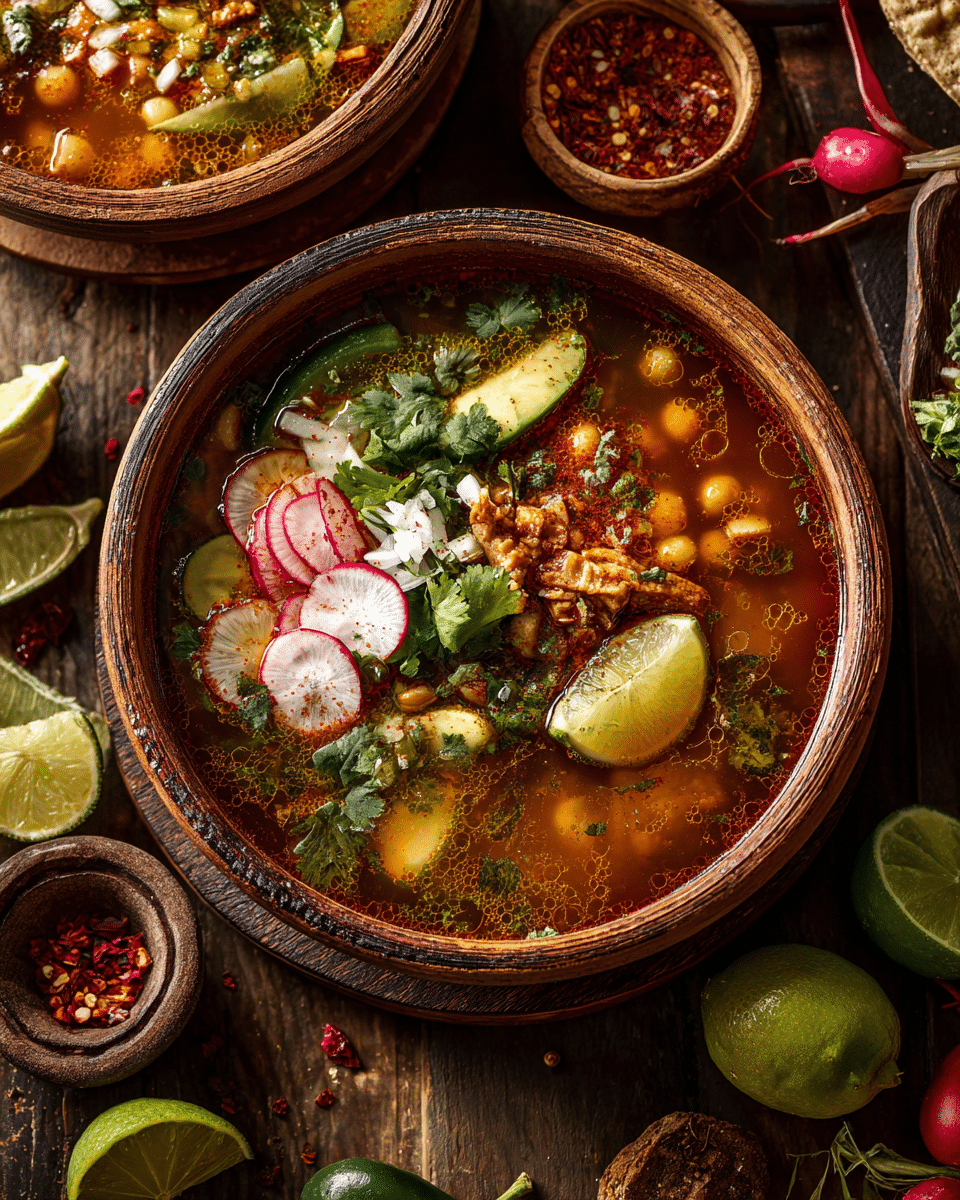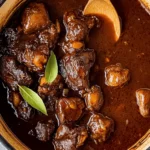Pozole is a traditional Mexican soup that has been enjoyed for centuries, originally made with hominy and meat in richly spiced broths. This vegan version delivers the same authentic depth of flavor without animal products, making it perfect for those who follow a plant-based diet. Whether you choose the vibrant Verde (green) made with tomatillos and green chilies or the bold Rojo (red) infused with dried red chilies, this dish is hearty, satisfying, and ideal for festive occasions like Mexican Independence Day.
FULL RECIPE
Ingredients
1.For the Base:
- 2 tablespoons olive oil
- 1 large onion, chopped
- 4 cloves garlic, minced
- 1 teaspoon ground cumin
- 1 teaspoon dried oregano (Mexican oregano preferred)
- 2 bay leaves
- 8 cups vegetable broth
- 2 (25-ounce) cans hominy, drained and rinsed
- Salt and pepper to taste
2.For Pozole Verde (Green):
- 1 pound tomatillos, husked and rinsed
- 2 poblano peppers, seeded and halved
- 2 jalapeños, seeded (optional for less heat)
- ½ cup fresh cilantro leaves
- Juice of 1 lime
3.For Pozole Rojo (Red):
- 4 dried guajillo chilies, stemmed and seeded
- 2 dried ancho chilies, stemmed and seeded
- 1 dried pasilla chili, stemmed and seeded
- 1 teaspoon smoked paprika
4.Garnishes:
- Shredded lettuce or cabbage
- Sliced radishes
- Chopped onions
- Fresh cilantro
- Lime wedges
- Avocado slices
- Tortilla chips or tostadas
Directions
- Prepare the green or red sauce
- For Verde: Roast tomatillos, poblanos, and jalapeños under a broiler until charred, about 6–8 minutes, turning halfway. Blend with cilantro and lime juice until smooth.
- For Rojo: Toast dried chilies in a skillet for 1–2 minutes until fragrant. Soak in hot water for 15 minutes to soften. Blend with smoked paprika and a little soaking water until smooth.
- Start the soup base
Heat olive oil in a large pot over medium heat. Add onion and cook until translucent, about 5 minutes. Stir in garlic, cumin, oregano, and bay leaves, cooking for 1 more minute until fragrant. - Add sauce and broth
Pour the prepared green or red sauce into the pot and cook for 3–4 minutes, stirring often. Add vegetable broth and hominy, then bring to a boil. - Simmer
Reduce heat and simmer uncovered for 25–30 minutes to allow flavors to meld. Season with salt and pepper to taste. - Serve
Ladle pozole into bowls and top with desired garnishes such as lettuce, radishes, onions, cilantro, avocado, and tortilla chips. Serve with lime wedges for added brightness.
Nutrition Facts
- Calories: 210
- Total Fat: 7g
- Saturated Fat: 1g
- Cholesterol: 0mg
- Sodium: 620mg
- Total Carbohydrates: 32g
- Dietary Fiber: 6g
- Sugars: 5g
- Protein: 6g
- Vitamin A: 15% DV
- Vitamin C: 35% DV
- Calcium: 6% DV
- Iron: 10% DV
Cultural Significance of Pozole
Pozole is a dish steeped in history, with origins tracing back to pre-Columbian Mexico. Traditionally made with hominy and pork, it was a ceremonial meal enjoyed during important gatherings and festivals. The soup’s name comes from the Nahuatl word “pozolli,” meaning “foamy,” referring to the puffed-up kernels of hominy that form the base of the dish. Over time, regional variations emerged, with Pozole Verde in the central and southern regions, Pozole Rojo in the north, and Pozole Blanco as a simpler version. The vegan adaptation maintains its cultural essence while making it accessible to a broader range of diets, including plant-based lifestyles.
Hominy: The Heart of the Dish
Hominy is the star of pozole, providing the distinctive chewy texture and slightly nutty flavor that make the soup unique. Made by soaking dried corn in an alkaline solution—a process known as nixtamalization—hominy is more digestible and nutrient-rich than regular corn. This ancient technique not only enhances the corn’s flavor but also boosts its calcium content and makes niacin (vitamin B3) more bioavailable. In vegan pozole, hominy delivers substance and heartiness that can easily stand in for meat, making the soup satisfying enough to be a main course.
The Verde and Rojo Flavor Profiles
One of the defining features of this recipe is the choice between two distinct styles: Verde and Rojo. Pozole Verde gets its vibrant green hue and bright flavor from tomatillos, poblano peppers, and cilantro, creating a tangy, fresh profile with a mild heat. Pozole Rojo, on the other hand, is rich, smoky, and earthy, thanks to dried chilies like guajillo, ancho, and pasilla. The color and flavor differences are so pronounced that they almost feel like two separate dishes, yet both share the same comforting base of hominy and spices.
Garnishes: Adding Texture and Freshness
One of the joys of eating pozole is customizing it with a variety of garnishes. Crisp shredded cabbage or lettuce adds crunch, while sliced radishes contribute a peppery bite. Fresh cilantro and chopped onions provide herbal brightness, and avocado slices lend a creamy richness. Lime wedges are essential for squeezing over the top, enhancing all the flavors with a zesty kick. These garnishes don’t just make the soup visually appealing—they also bring layers of texture and flavor, transforming each spoonful into a dynamic eating experience.
Pairing Ideas for a Complete Meal
Vegan pozole pairs wonderfully with a range of side dishes and beverages. Warm, freshly made corn tortillas or crispy tostadas make perfect companions, ideal for dipping into the broth or topping with garnishes. For a more indulgent side, try vegan quesadillas or tamales. Drinks such as agua fresca, horchata, or hibiscus tea complement the soup’s spice and balance its richness. For festive occasions like Mexican Independence Day, pairing pozole with other traditional plant-based dishes creates a well-rounded and culturally rich dining experience.
Regional Variations and Creative Twists
While the Verde and Rojo versions are the most common, vegan pozole can be adapted with creative twists. Some cooks add mushrooms, jackfruit, or hearts of palm to mimic the texture of shredded meat. Others incorporate roasted vegetables like zucchini or sweet potatoes for added sweetness and depth. Regional variations also influence spice levels and herb choices—some areas favor epazote for an earthy flavor, while others lean heavily on fresh oregano. Experimenting with these elements allows you to tailor the recipe to personal taste or seasonal availability.
Tips for Achieving the Best Flavor
The key to a deeply flavorful pozole lies in developing layers of taste. Roasting or toasting the chilies and vegetables before blending intensifies their natural sweetness and smokiness. Allowing the soup to simmer for at least 30 minutes after combining the sauce and broth helps the flavors meld beautifully. Using high-quality vegetable broth instead of plain water adds depth, and seasoning in stages ensures that the flavor builds gradually. Finally, always taste before serving—sometimes an extra squeeze of lime or pinch of salt can take the dish from good to unforgettable.
Storage and Reheating Advice
Vegan pozole is one of those dishes that tastes even better the next day as the flavors continue to develop. Store leftovers in an airtight container in the refrigerator for up to four days. If freezing, keep the broth and garnishes separate for the best texture—pozole freezes well for up to three months. When reheating, do so gently over medium heat to avoid overcooking the hominy. Fresh garnishes should always be added just before serving to maintain their crispness and vibrancy.
Advertisement
Serving for Special Occasions
Pozole is traditionally served during large gatherings, making it perfect for celebrations like birthdays, holidays, and cultural events. For Mexican Independence Day, serving pozole in large clay bowls with an array of colorful garnishes creates a visually stunning and festive table. The communal nature of the dish encourages guests to customize their bowls to their liking, making the meal interactive and memorable. It’s also a wonderful way to introduce non-Mexican guests to the richness of traditional flavors in a vegan-friendly format.
Conclusion
Vegan pozole, whether prepared as the tangy Verde or the smoky Rojo, is a dish that bridges cultural tradition and modern dietary preferences. Its rich history, bold flavors, and customizable nature make it a standout choice for both everyday meals and special celebrations. The combination of hearty hominy, vibrant sauces, and fresh garnishes ensures a balanced and satisfying dining experience.






